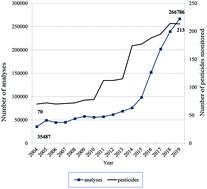当前位置:
X-MOL 学术
›
Environ. Sci.: Processes Impacts
›
论文详情
Our official English website, www.x-mol.net, welcomes your feedback! (Note: you will need to create a separate account there.)
Monitoring of pesticides in drinking water: finding the right balance between under- and over-monitoring – experience from the Czech Republic
Environmental Science: Processes & Impacts ( IF 5.5 ) Pub Date : 2021-1-7 , DOI: 10.1039/d0em00389a Filip Kotal 1, 2, 3 , František Kožíšek 1, 2, 3 , Hana Jeligová 1, 2, 3 , Adam Vavrouš 1, 2, 3 , Lenka Mayerová 1, 2, 3 , Daniel W. Gari 1, 2, 3 , Alena Moulisová 1, 2, 3
Environmental Science: Processes & Impacts ( IF 5.5 ) Pub Date : 2021-1-7 , DOI: 10.1039/d0em00389a Filip Kotal 1, 2, 3 , František Kožíšek 1, 2, 3 , Hana Jeligová 1, 2, 3 , Adam Vavrouš 1, 2, 3 , Lenka Mayerová 1, 2, 3 , Daniel W. Gari 1, 2, 3 , Alena Moulisová 1, 2, 3
Affiliation

|
The modern, risk-based approach requires that only those pollutants which are likely to be present in a given water supply should be monitored in drinking water. From this perspective, defining an adequate approach to the monitoring of pesticides in areas with intensive agriculture is currently one of the greatest issues of regulation. This article shows the development and detailed results of pesticide monitoring in drinking water in the Czech Republic (CR). More than 4000 water supply zones serving around a 9.5 million population are routinely monitored, with nearly 250 thousand analyses of over 200 different pesticides and their metabolites being performed every year, with a non-compliance rate of ca. 0.3%. In 2017, pesticides accounted for most derogations in the CR, concerning a total of 64 water supply systems serving more than a 250 thousand population. A representative survey targeting 21 selected chemicals showed that 75% of water supply systems contained up to 11 pesticides per sample. The most commonly found were metabolites of the herbicides used to protect oilseed rape, maize, and sugar beet: acetochlor ESA, alachlor ESA, metazachlor OA, and chloridazon-desphenyl. The health risk assessment did not reveal any risks from these chemicals, even at the highest levels detected or in the most abundant mixtures, to the most vulnerable population (infants). Nevertheless, the increased presence of pesticides undermines the public's trust in drinking water safety.
中文翻译:

监测饮用水中的农药:在监测不足和监测过度之间找到适当的平衡–捷克共和国的经验
现代的基于风险的方法要求仅在饮用水中监测那些可能存在于给定供水中的污染物。从这个角度出发,在集约化农业地区确定一种适当的农药监测方法是当前最大的监管问题之一。本文显示了捷克共和国(CR)中饮用水中农药监测的发展和详细结果。例行监测了服务于大约950万人口的4000多个供水区,每年对200多种不同的农药及其代谢产物进行近25万次分析,违规率大约为90。0.3%。2017年,农药是CR减损最严重的部分,涉及64个供水系统,服务于25万以上的人口。一项针对21种选定化学品的代表性调查显示,每个样本中有75%的供水系统中含有多达11种农药。最常见的发现是用于保护油菜,玉米和甜菜的除草剂的代谢产物:乙草胺ESA,甲草胺ESA,间草胺OA和氯达唑烷-去苯基。健康风险评估没有揭示这些化学物质对最弱势人群(婴儿)的任何风险,即使是检测到的最高含量或混合物中含量最高的混合物。然而,杀虫剂含量的增加破坏了公众对饮用水安全的信任。
更新日期:2021-01-18
中文翻译:

监测饮用水中的农药:在监测不足和监测过度之间找到适当的平衡–捷克共和国的经验
现代的基于风险的方法要求仅在饮用水中监测那些可能存在于给定供水中的污染物。从这个角度出发,在集约化农业地区确定一种适当的农药监测方法是当前最大的监管问题之一。本文显示了捷克共和国(CR)中饮用水中农药监测的发展和详细结果。例行监测了服务于大约950万人口的4000多个供水区,每年对200多种不同的农药及其代谢产物进行近25万次分析,违规率大约为90。0.3%。2017年,农药是CR减损最严重的部分,涉及64个供水系统,服务于25万以上的人口。一项针对21种选定化学品的代表性调查显示,每个样本中有75%的供水系统中含有多达11种农药。最常见的发现是用于保护油菜,玉米和甜菜的除草剂的代谢产物:乙草胺ESA,甲草胺ESA,间草胺OA和氯达唑烷-去苯基。健康风险评估没有揭示这些化学物质对最弱势人群(婴儿)的任何风险,即使是检测到的最高含量或混合物中含量最高的混合物。然而,杀虫剂含量的增加破坏了公众对饮用水安全的信任。



























 京公网安备 11010802027423号
京公网安备 11010802027423号